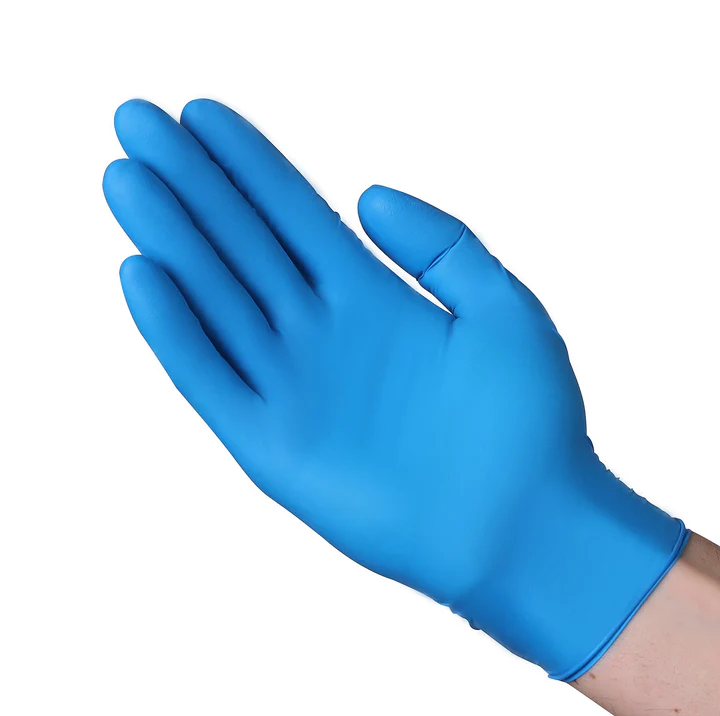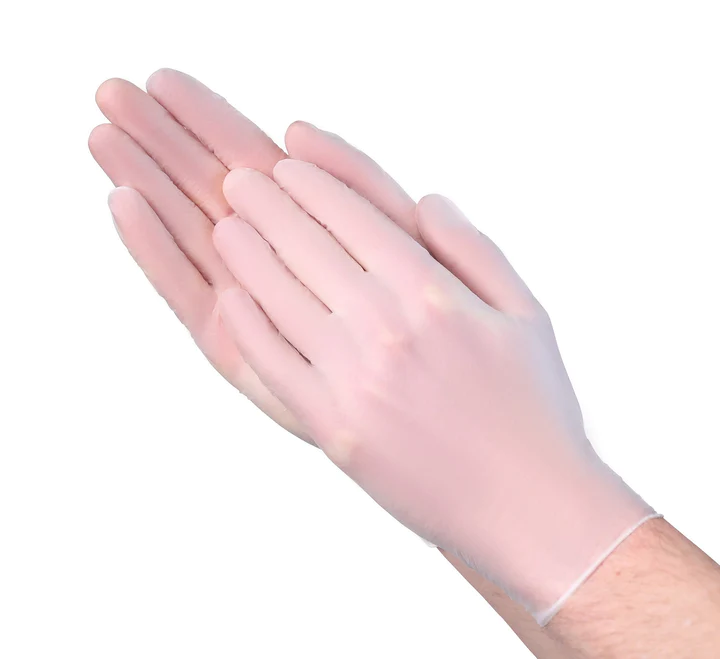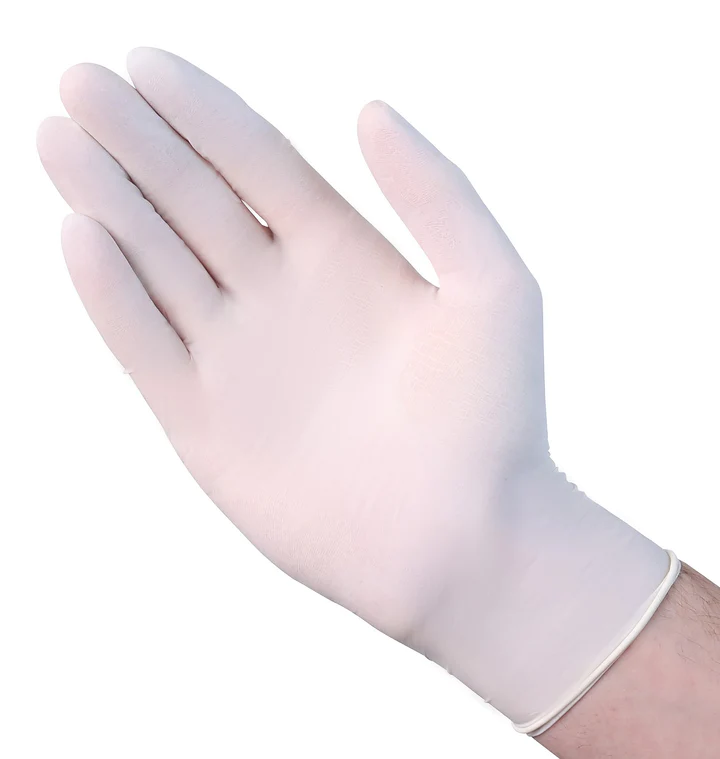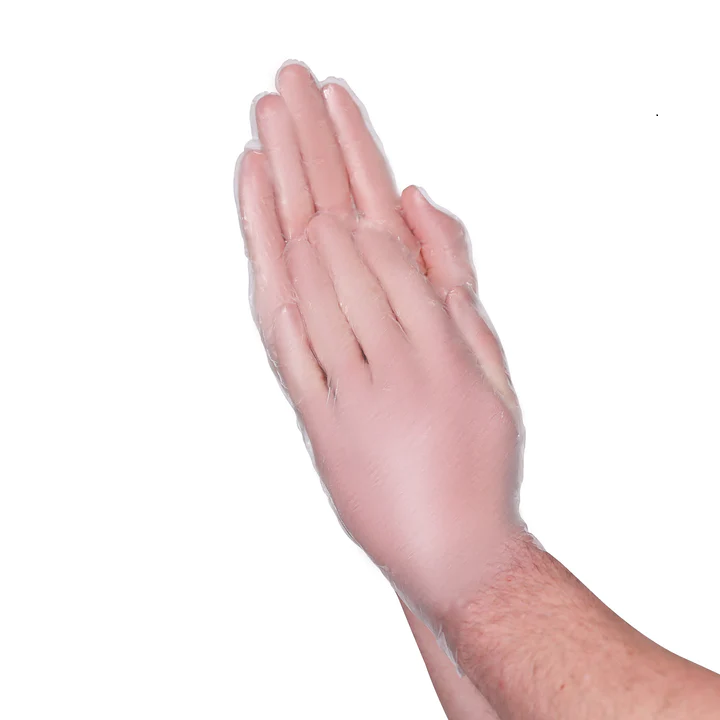While much of healthcare is still heavily reliant on essential supplies such as disposable gloves, they are hardly the simplest items to select. Different materials, sizes, and thickness all come into play when selecting a glove that best fits your needs, so how do you make sure you’re getting the right ones for your practice? We at Uncle Supply have taken the guesswork out of choosing gloves with The Definitive Guide to Disposable Gloves. This comprehensive guide explains the ins and outs of disposable gloves for medical professionals in an easily-understood format.
Explore this guide if you’re looking for more information on glove fitment issues as well as usage instructions that can help keep your hands and your patients’ hands safe from germs or any other contaminants.
Disposable gloves provide various physical and chemical protections while also reducing the spread of germs. In order to best suit your needs, it is important to understand the options when it comes to medical glove materials.
Nitrile is a type of synthetic rubber commonly used for medical gloves, as its resistance to punctures makes it valuable in areas that require greater tactile sensitivity and dexterity.
Vinyl is another synthetic material that provides an economic alternative due to its lower manufacturing costs but still retains the necessary puncture resistance.
Furthermore, there are Latex Gloves, which are designed to be highly elastic and sturdy, while Polyethylene Gloves are thin yet can be used for multiple tasks without deteriorating or compromising any protection offered.
All of these materials have been utilized in production, with nitrile gloves being the most common given their durability, comfort, and effectiveness in hazardous situations.
Glove selection can often be overwhelming with the variety of styles. But beyond these materials, it is important to consider glove specifications like thickness, weight, cuff length, and other details such as if the glove is ambidextrous, textured or diamond textured.
Choosing the right glove specification is essential to providing optimal protection without compromising dexterity or comfort while on task. Careful consideration should be taken when selecting the right glove to ensure you have a well rounded and effective product suited for the job at hand.
Glove physical performance is often measured using the Acceptable Quality Limit (AQL), tensile strength, and ultimate elongation. AQL represents the maximum acceptable defect level, while tensile strength indicates the maximum amount of direct stress a glove can endure before it breaks. Ultimate elongation reflects how much the glove material can stretch before stretching too far and breaking. Determining the best glove for a specific task requires assessing all these performance parameters for each type of glove material.
There are two main categories of glove grades available on the market today: exam grade and industrial grade.
Exam Grade gloves are often required for medical professionals who need maximum protection during their everyday activities. They are normally configured to provide grip, dexterity, durability, and fit while meeting requirements set by the ASTM (American Society for Testing and Materials).
Industrial Grade gloves, on the other hand, are designed primarily with strength and reliability in mind. These gloves offer wide ranging protection from cuts and chemicals, making them ideal for marine construction projects or petrochemical refineries. With all grades, including exam and industrial, coming in a variety of shapes and sizes, it’s important to find the perfect grade for any application.
Nitrile gloves are a popular choice for a wide range of industries and applications due to their superior strength and puncture resistance compared to other disposable glove materials. When selecting nitrile gloves, it is important to consider the specifications of the gloves to ensure they meet the requirements of your specific task or application.
Glove thickness is a critical factor when selecting nitrile gloves. Thicker gloves offer increased protection against punctures, cuts, and abrasions, but can also reduce dexterity and tactile sensitivity. Typically, nitrile gloves are available in thicknesses ranging from 3 to 8 mils, with 4 to 6 mils being the most common.
Glove weight is another important consideration. Gloves with a higher weight indicate a denser material and can provide increased durability and protection. However, heavier gloves can also be less flexible and comfortable to wear for extended periods of time. Nitrile gloves typically range in weight from 3 to 6 grams per pair.
Cuff length is another specification to consider when selecting nitrile gloves. Longer cuffs provide increased protection against spills and splashes, while shorter cuffs offer more flexibility and comfort. Nitrile gloves are available with cuffs ranging from standard 9.5-inch length to extended 12-inch length.
Ambidextrous gloves are designed to fit either hand, providing ease and convenience in donning and doffing the gloves. This eliminates the need for left and right hand-specific gloves, simplifying inventory management and reducing costs.
Textured nitrile gloves feature a textured surface to enhance grip and provide better control when handling wet or oily objects. This feature is especially useful in industries such as foodservice, healthcare, and automotive, where secure grip is crucial for safe and efficient handling of objects.
When it comes to nitrile gloves, physical performance is an important consideration to ensure that the gloves can provide the necessary protection and performance for a given task. There are several key factors to consider in terms of nitrile glove physical performance. While a good starting point, more can be found in our article, Why Disposable Nitrile Gloves Are Absolutely Essential.
Acceptable quality levels (AQL) are a measure of the quality and consistency of gloves. A lower AQL means that there are fewer defects in the gloves and a higher level of consistency in terms of sizing, thickness, and performance. AQL is typically measured on a scale from 1.5 to 4, with a lower number indicating higher quality.
Tensile strength is a measure of a glove’s ability to withstand stretching and pulling without tearing. This is an important factor for gloves that will be subjected to heavy use or stress. Tensile strength is typically measured in pounds per square inch (PSI) and higher values indicate greater strength and durability.
Ultimate elongation is a measure of a glove’s ability to stretch without breaking. This is important for gloves that need to provide flexibility and range of motion while also maintaining their structural integrity. Ultimate elongation is typically measured as a percentage and higher values indicate greater flexibility.
By selecting gloves with appropriate physical properties, you can ensure that your workforce is equipped with gloves that provide the necessary protection and performance for their specific job duties.

Nitrile gloves are made from synthetic rubber and are used in numerous industries. They have quickly become incredibly popular, as they offer better puncture and chemical resistance than latex gloves, allowing for use in industries such as health care, medical examination, general industry, automotive, and food processing.
Nitrile gloves are commonly used in the medical industry, particularly in hospitals, long-term care facilities, and ambulatory clinics, due to their durability and impermeability. They also deliver an excellent source of protection for those working in laboratory or pharmaceutical environments.
In addition, workers in the food processing or production industries utilize nitrile gloves for high levels of hygiene when handling food products like meat and poultry.
First responders such as police officers, firefighters, and paramedics are at high risk of fentanyl exposure while they’re out on the job. Many of those responding to overdoses and other fentanyl-related emergencies could accidentally come into contact with fentanyl through the air or their skin. This is why it’s essential for them to have the right gear for their safety when working with fentanyl, including N95 respirators, safety glasses, and especially nitrile gloves.
There are now also specialized Nitrile gloves that are resistant to not just fentanyl (ASTM D6978), but also other hazardous substances, including petroleum-based fluids, paints, construction materials, and even animal fats. Plus, they’re far more puncture resistant than latex gloves, so first responders can have confidence in their protection when handling any potential fentanyl threats.
Vinyl gloves are a popular choice in the disposable glove market due to their low cost and versatility. They are made from synthetic PVC material and are suitable for a variety of applications, such as food handling, healthcare, cleaning, and more. Vinyl gloves are available in different specifications, including thickness, weight, cuff length, and ambidextrous design.
Glove thickness is an important specification to consider when selecting vinyl gloves. Generally, vinyl gloves are thinner than other glove materials such as nitrile and latex. The thickness can range from 2 to 6 mils, with the thicker gloves providing better protection but reducing dexterity. Glove weight refers to the weight of a single glove and is measured in grams. Vinyl gloves can range from 3 to 6 grams per glove, with heavier gloves providing better durability and less likelihood of tearing.
Vinyl gloves are available in standard and extra-long cuff lengths to provide better protection for the wrist and forearm. The cuff length can range from 9 to 12 inches, with longer cuffs offering greater protection against splashes and spills.
Vinyl gloves are ambidextrous. This feature adds convenience to the wearer and reduces the need to sort gloves into left- or right-handed pairs. In summary, vinyl gloves are a cost-effective solution that offers versatility, comfort, and protection for a range of applications.
In addition to the specifications mentioned earlier, the physical performance of vinyl gloves is also an important consideration when selecting the right gloves for a specific application. One factor to consider is the AQL, or acceptable quality level, which refers to the maximum number of defective gloves in a batch of gloves that is considered acceptable. The AQL of vinyl gloves is typically 1.5 or 2.5, which means that there should be no more than 15 or 25 defective gloves per 1,000 gloves, respectively.
Another factor to consider is the tensile strength of vinyl gloves. Tensile strength measures the force required to break a glove and is expressed in pounds per square inch (PSI). Vinyl gloves have lower tensile strength compared to other materials, such as nitrile and latex. However, vinyl gloves are still strong enough to provide adequate protection against common chemicals and pathogens. The ultimate elongation of vinyl gloves is also important, as it measures the ability of the gloves to stretch before breaking. Vinyl gloves have an ultimate elongation of approximately 300%, which means that they can stretch up to three times their original length before breaking.
Vinyl gloves have specific physical performance characteristics that make them suitable for certain applications. While they have lower tensile strength compared to other materials, they are still strong enough to provide protection and have a high ultimate elongation, which allows for flexibility and dexterity. The acceptable quality levels of vinyl gloves also ensure that the gloves meet industry standards and provide consistent quality for your specific needs.

Vinyl gloves are a popular choice in a variety of industries due to their low cost, versatility, and ease of use. One of the most common uses for vinyl gloves is in the food industry. They are ideal for food handling and preparation, as they provide a barrier to protect against contamination and are easy to put on and take off. They are also commonly used in healthcare settings for non-sterile procedures, such as administering medication or performing routine examinations. Additionally, vinyl gloves are often used in the janitorial and cleaning industries to protect against harsh cleaning chemicals and other irritants.
Aside from the industries mentioned, vinyl gloves can be used in a wide range of other applications, such as hairdressing, painting, and automotive repair. They are also suitable for people with latex allergies, as they are made from synthetic materials and do not contain natural rubber latex proteins that can cause allergic reactions. The ease of use and affordability of vinyl gloves make them a popular choice for many different applications, from household chores to industrial tasks.
Latex gloves are a popular choice in the disposable glove market due to their durability, comfort, and elasticity. They are made from natural rubber latex and are suitable for a variety of applications, including medical, dental, food service, and industrial settings. Like vinyl gloves, latex gloves are available in different specifications, including thickness, weight, cuff length, and ambidextrous design.
Glove thickness is an important specification to consider when selecting latex gloves. Generally, latex gloves are thicker than vinyl gloves, with the thickness ranging from 5 to 8 mils. Thicker gloves provide better protection against chemicals and pathogens, but may reduce dexterity. Glove weight refers to the weight of a single glove and is measured in grams. Latex gloves can range from 5 to 8 grams per glove, with heavier gloves providing better durability and less likelihood of tearing.
The cuff length of latex gloves can range from 9 to 12 inches, with longer cuffs offering greater protection against splashes and spills. Lastly, latex gloves are ambidextrous. This feature adds convenience to the wearer and reduces the need to sort gloves into left- or right-handed pairs.
Latex gloves are known for their excellent physical performance, making them another popular choice in a variety of industries. One important factor to consider when selecting latex gloves is the acceptable quality level (AQL), which measures the maximum number of defective gloves in a batch of gloves that is considered acceptable. The AQL for latex gloves is typically 1.5, which means that there should be no more than 15 defective gloves per 1,000 gloves. This ensures that the gloves meet industry standards and provide consistent quality for the user.
Tensile strength is also an important physical performance characteristic of latex gloves. Tensile strength, again measures the force required to break a glove and is expressed in pounds per square inch (PSI). Latex gloves have high tensile strength, which means that they are less likely to tear or puncture during use. Additionally, the ultimate elongation of latex gloves is also high, measuring up to 750%. This high level of stretchiness allows for greater dexterity and comfort for the user.
Latex gloves are a durable and high-performing option that provides excellent protection and comfort for a wide range of applications. The acceptable quality level ensures that the gloves meet industry standards, while the high tensile strength and ultimate elongation provide excellent physical performance. These factors, in addition to their comfort and elasticity, make latex gloves a popular choice in healthcare and many other sectors.

One of the most common uses for latex gloves is in the healthcare industry. They are used by doctors, nurses, and other healthcare professionals to prevent the spread of infectious diseases and protect themselves and their patients. Additionally, latex gloves are often used in the dental industry for procedures such as fillings and cleanings. The high tactile sensitivity of latex gloves also makes them useful for laboratory work, such as handling chemicals or specimens.
In addition to the healthcare industry, latex gloves are also commonly used in the food service industry. They are used by food handlers to prevent the spread of bacteria and maintain hygiene standards. The high tensile strength of latex gloves also makes them suitable for tasks that require a lot of manual dexterity, such as food preparation and handling.
Latex gloves are also used in industrial settings such as manufacturing, automotive, and construction. The gloves provide protection against chemicals, oils, and solvents, and are often used when handling sharp or abrasive materials. The high elasticity of latex gloves also makes them suitable for tasks that require flexibility and grip.
Latex gloves’ versatility, durability, and tactile sensitivity make them a popular choice for tasks that require protection and manual dexterity.
A specification to consider when selecting polyethylene gloves is the glove weight, which is typically measured in grams. Polyethylene gloves are lightweight and typically weigh between 0.6 and 1.5 grams per glove. This makes them a cost-effective option, especially for tasks that require a high volume of glove changes.
Polyethylene gloves typically come in an ambidextrous design, which means that they can be worn on either hand. They also have a standard cuff length of 9 inches, which provides adequate protection for the user’s wrist and lower arm. The ambidextrous design and standard cuff length make polyethylene gloves a versatile option for a range of tasks, from food service to janitorial work.
Polyethylene gloves are a cost-effective and versatile option for tasks that require protection and manual dexterity. Their low thickness and lightweight design provide the user with a more tactile feel, while the ambidextrous design and standard cuff length make them easy to use and suitable for a range of tasks.
One of the key specifications of polyethylene gloves is the glove thickness, which is typically measured in mils. Polyethylene gloves are generally thinner than other types of gloves, with a typical thickness of 1-3 mils. The lower thickness allows the user to have more tactile sensitivity, which is particularly useful for tasks that require precision and manual dexterity.
When it comes to the physical performance of polyethylene gloves, there are a few key factors to consider. One of these is the AQL, or acceptable quality level. AQL is a standard that determines the maximum number of defects that are acceptable in a batch of gloves. A lower AQL indicates a higher quality product. Polyethylene gloves typically have a higher AQL than other types of gloves, such as nitrile or latex, due to their lower manufacturing costs.
Another factor to consider is the tensile strength of polyethylene gloves, which refers to the amount of force that the gloves can withstand before breaking. Polyethylene gloves generally have a lower tensile strength than other types of gloves, which means that they are more prone to tearing or puncturing. However, their lower thickness and lighter weight make them suitable for low-risk applications where the risk of contamination is low.
The ultimate elongation of polyethylene gloves is another important physical performance factor to consider. Ultimate elongation refers to the maximum amount that the gloves can stretch before breaking. Polyethylene gloves have a high ultimate elongation, which makes them more flexible and comfortable to wear than other types of gloves. This makes them a popular choice for tasks that require a high level of manual dexterity, such as food preparation or light cleaning.
Polyethylene gloves have a higher AQL and lower tensile strength than other types of gloves, but they have a high ultimate elongation and are more flexible and comfortable to wear. Their physical performance factors make them a good option for low-risk tasks that require a high level of manual dexterity.

Polyethylene gloves are typically used for low-risk applications because they have a higher chance of tearing or puncturing than other types of gloves.
In the food service industry, polyethylene gloves are often used for food handling and preparation. They provide a barrier between the food and the worker’s hands, which helps prevent contamination. They are also commonly used in the janitorial and cleaning industries for tasks such as light cleaning or handling cleaning chemicals. Polyethylene gloves are a popular choice in these industries due to their lightweight design and ease of use.
Polyethylene gloves are also used in healthcare settings, such as long-term care facilities or in-home care. They are used for tasks that require protection and manual dexterity, such as changing wound dressings or administering medications. However, they are not suitable for tasks that involve exposure to blood or other bodily fluids, as they do not provide adequate protection.
Polyethylene gloves are widely used in the food service, janitorial, and cleaning industries, as well as in certain healthcare settings, for low-risk applications that require protection and manual dexterity.
Disposable gloves are an essential item in many industries, from healthcare and food service to janitorial and cleaning. They provide a protective barrier between workers and potentially harmful materials, reducing the risk of contamination and infection. However, with so many different types of disposable gloves on the market, it can be difficult to know which one to choose.
At Uncle Supply, we are committed to providing high-quality disposable gloves to our customers. Each type of glove has its own unique features and benefits, making it important to choose the right glove for the job, which we hope you have found helpful in our Definitive Guide to Disposable Gloves.
We believe that our customers deserve the best quality products at an affordable price. Our gloves are manufactured to the highest standards, with strict quality control measures in place to ensure that every glove meets our high standards. We offer a wide range of sizes and styles to meet the needs of different industries, and we are committed to providing exceptional customer service to ensure that our customers are satisfied with their purchase.
In conclusion, the choice of disposable gloves will depend on the needs of your industry and the tasks you are performing. Uncle Supply offers a range of high-quality gloves at an affordable price, making us the first choice for many businesses. Whether you need nitrile, latex, vinyl, or polyethylene gloves, we have the right product for your needs. Contact us today to learn more about our products and how we can help meet your disposable glove needs.